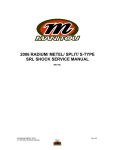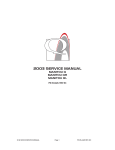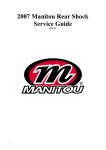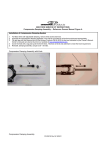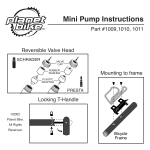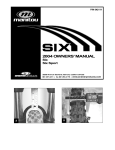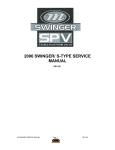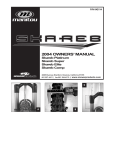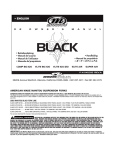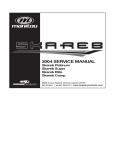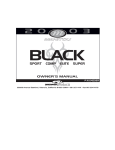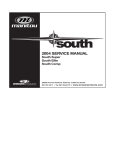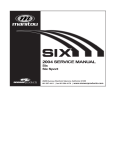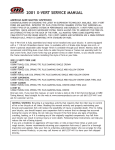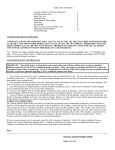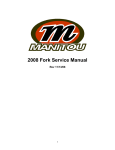Download 2004 SERVICE MANUAL Manitou Q shocks
Transcript
2004 SERVICE MANUAL Manitou Q shocks 28209 Avenue Stanford, Valencia, California 91355 661 257-4411 | fax 661 294-4179 | www.answerproducts.com 04 Q SHOCK SERVICE MANUAL INDEX Section Description Page 1 INTRODUCTION 3 2 SETUP, TUNING, PERIODIC MAINTENANCE 3 3 GLOSSARY 4 4 COMPLETE SHOCK LESS HARDWARE 5 5 HARDWARE REMOVAL AND INSTALLATION 5 6 DU BUSHING REMOVAL AND INSTALLATION 6 7 AIR CANISTER 8 8 AIR CANISTER REMOVAL AND SEAL SERVICE 9 9 DAMPING SYSTEM 11 10 TROUBLESHOOTING 12 11 TABLE 1: FASTENER TORQUE REQUIREMENTS 13 12 Q SHOCK SERVICE KITS 14 Contact Information Answer Products Customer Service Department 28209 Ave. Stanford Valencia, CA 91355 Toll Free: (800) 423-0273 Direct : (661) 257-4411 FAX: (661) 775-1798 E-mail: [email protected] [email protected] Web site: www.answerproducts.com 04 Q SHOCK SERVICE MANUAL Page 2 PN 042132 REV NC SECTION 1: INTRODUCTION This manual is intended to guide the user through basic service of Manitou Q rear shocks. Service is supported by the identification of common parts and assemblies that have been assembled into Service Kits. The purpose of this manual will be to describe conditions that may drive the need for service and to provide installation instructions for the kits. Due to the time-consuming nature rear shock service, at this time our primary focus is to offer service kits that minimize the amount of downtime and labor involved. As the program matures, and we are able to gather feed back from our customers, we may offer kits to a more detailed level. GENERAL WARNING: Rear shocks by design contain gases and fluids under extreme pressure and warnings contained in this manual must be observed to reduce the possibility of injury or possible death. Following these instructions can help you reduce the risk of being injured. Any questions in regards to the information in this manual should be directed to Answer Products Customer Service at (661) 257-4411. CAUTION: The Q Shock uses compressed air to provide fluid pressure in the damping system and spring resistance. These systems must be relieved of pressure prior to servicing. Failure to relieve air pressure could result in injury or possible death. CAUTION: The Q Shock uses precision machined aluminum and other soft alloy components. Using correct tools for assembly is essential to prevent damage. SECTION 2: SETUP, TUNING, PERIODIC MAINTENANCE Instructions for shock setup, tuning, and periodic rider maintenance is not covered in detail in this manual. Please refer to the Manitou Q Rear Shock Owner's Manual (PN 042107) for that information. If you did not receive a manual, you can download one at www.answerproducts.com or contact Answer Products Customer Service at (661) 257-4411. 04 Q SHOCK SERVICE MANUAL Page 3 PN 042132 REV NC SECTION 3: GLOSSARY OF TERMS Air Canister – Can that holds the air spring air in an air shock. Bottom Out – Point at which a shock reaches full compression. Control Eyelet (C-End) – Eyelet that is on the rebound adjuster end of a shock. The air canister is attached to this end on air shocks. Damper Eyelet (D-End) - Eyelet that is on the damper body end of a shock. Damper Body – Section of shock that contains the damping system Damper Shaft – Shaft attached to the damper piston that connects the two moving sections (damping system and control eyelet) of the shock together. Damping System - Controls compression and rebound rate (speed). DU Bushing – Teflon guide bushing pressed into the eyelets. Mounting hardware is inserted into the DU bushings and rotates within the bushing as need by the suspension design. Eyelet – Found on each end of the shock, it is where the DU bushing and mounting hardware are and provides the connection between the shock and bicycle. Internal Floating Piston (IFP) - A floating piston that separates damping oil from the damping system air chamber. Lockout - Found on QRL shocks. The Manitou lockout significantly increases the amount of load required to compress the shock. The lockout does not prevent compression under load, only increases the amount of load required to compress the shock. Mounting Hardware – Hardware that allows shocks to be mounted into the wide variety of suspension designs. Schrader, Air – Black in color, it is the valve for pressurizing the air canister in an air shock Seals: O-Rings - Black synthetic rubber with a round cross section. Primarily used for fluid sealing. Seals: Quad Seals - : Black synthetic rubber with an “X” cross section, primarily used for sealing air. Seals: Wipers – Teflon ring, used for keeping debris out of quad seals, guiding the damper piston, and providing support. Top Out – Point at which a shock returns to its full extension. 04 Q SHOCK SERVICE MANUAL Page 4 PN 042132 REV NC SECTION 4: COMPLETE SHOCK LESS MOUNTING HARDWARE The highest-level kit offered will be a complete shock without mounting hardware. These kits are offered as a fast replacement where all that is need is to change out the hardware or damping unit. Q Shock – Less Mounting Hardware SECTION 5: HARDWARE REMOVAL AND INSTALLATION Mounting hardware is used to mount shocks to the various frame configurations. Over time, hardware may wear between the mounting bolts or DU Bushing which will result in play in the connection. Remove hardware using pliers as shown in Figure 1 DU Bushing Eyelet . Figure 1 Figure 2 HARDWARE REPLACEMENT Hardware should have a slight press fit into the DU bushing and can be tapped in place with a rubber mallet or soft jaws in a vise. Apply a small amount of thick grease such as Motorex Bike Grease 2000 (PN 85-0033) to the hardware before installation. There are virtually an infinite number of hardware combinations in use on bikes today. When ordering hardware from Answer Products, It will be necessary to identify the overall eyelet width, eyelet width, and mounting hole diameter. 04 Q SHOCK SERVICE MANUAL Page 5 PN 042132 REV NC HARDWARE REMOVAL AND INSTALLATION- (CONT.) 1. Measure the overall eyelet width. 2. Measure hole size. Current hardware are designed to accept a 6mm or 8mm fastener. 3. Measure eyelet width. SECTION 6: DU BUSHING REMOVAL AND INSTALLATION DU bushings are press fit into the shock eyelets at each end of the shock. The hardware fit into the bushings and will rotate slightly within the bushing during suspension compression. DU Bushings, like hardware, may wear over time. Removal and installation is accomplished using tool PN 85-6075. REMOVAL 1. Remove hardware from the shock. 2. Insert unthreaded end of punch into the removal tool first and screw in about half a turn. Punch 04 Q SHOCK SERVICE MANUAL Page 6 PN 042132 REV NC DU BUSHING REMOVAL AND INSTALLATION (CONT.) 3. Clamp removal tool in vise. 4. Insert eyelet into tool. 5. Use 6mm hex wrench to screw in punch, making sure that it is centered on the bushing. This will press out the bushing. INSTALLATION 1. Place a bushing onto the threaded end of the punch and into the removal tool; screw in about half a turn. Bushing 2. Clamp removal tool in vise. 3. Insert eyelet into tool. 4. Use 6mm hex wrench to screw in punch, making sure that it is centered on the bushing and that the bushing is centered to the eyelet. This will press in the bushing. 04 Q SHOCK SERVICE MANUAL Page 7 PN 042132 REV NC SECTION 7: AIR CANISTER WARNING: Manitou Q Air Shocks use compressed air to provide resistance to compression in place of a coil spring. You must be certain that the air canister is relieved of all pressure prior to servicing the air system. Failure to relieve air pressure could result in injury or possible death. Failure of an air shock to maintain air pressure is usually the result of defective or worn seals. If there is suspicion of an air leak, the location can be isolated by spraying the air canister joints with a mild solution of dish soap and water. Bubbles will form in from the area of leakage. You can also immerse the shock in water to locate the leak. Sealing of the shock is accomplished through a series if o-rings, quad seals, and wipers. When the air canister is removed, these seals can be replaced from Seal Kit C. Seal Descriptions: O-Rings: Black synthetic rubber with a round cross section. Used for fluid sealing. Quad Seals: Black synthetic rubber with an “X” cross section, used for sealing air. Wipers: White Teflon, used for keeping debris out of quad seals. Adjuster Eyelet Schrader 1. For leaks at the adjuster eyelet or damper end of the air canister, refer to the detailed disassembly instructions below. 2. For leaks at the Schrader valve, release all air pressure and replace the Schrader valve core or assembly as needed. 3. If when you pressurize the air canister the shock collapses to its shortest travel position, the shock has an air piston leak into the negative chamber. Place the shock in the shock tester and extend it to its full travel. Depress the adjuster eyelet Schrader while the shock is extended under load. If it remains in the full travel position, refer to the detailed disassembly instructions below for instructions on servicing the air canister and piston seals. Shock in Shortest Travel Position 4. If the shock returns to the short travel position, it is not serviceable and the entire shock must be replaced. WARNING: Attempting to service a shock with this condition could result in injury or possible death. 04 Q SHOCK SERVICE MANUAL Extend to long travel and depress the air canister Schrader Valve Page 8 PN 042132 REV NC SECTION 8: AIR CANISTER REMOVAL AND SEAL SERVICE 1. Failure of an air shock to maintain air pressure is usually the result of defective or worn seals. If there is suspicion of an air leak, pressurize the air canister to 150psi from the adjuster eyelet Schrader Valve. Locate the leak by spraying the air canister and Schrader joints with a mild solution of dish soap and water or submerge in a bucket of water. Bubbles will form in from the area of leakage. 2. Release All air pressure from air canister. Remove hardware as shown under HARDWARE REMOVAL AND INSTALLATION. For leaks at the Schrader valves, release all air pressure and replace the Schrader valve core or assembly as needed. The core is removed using a standard core removal tool. The assembly is removed by removing the core and unscrewing the assembly by inserting a 3mm hex into the center of the valve. Air release Schrader valve 3. Place adjuster eyelet in a vise using soft jaws. Using a rubber strap wrench to prevent damage, loosen the air canister completely 04 Q SHOCK SERVICE MANUAL Page 9 PN 042132 REV NC AIR CANISTER REMOVAL AND SEAL SERVICE (CONT.) Damper Cap: DO NOT REMOVE 4. Slide air canister away from the canister eyelet and remove. WARNING: Do not remove the damper cap. The damper system is under extreme pressure. Removal of the damper cap without releasing damper system pressure will result in the possibility of injury or possible death. 5. Replace o-rings, seals, and wipers in the air canister and air piston. Air Canister Kit A will have new seals installed as part of the kit. Also replace the o-ring inside the canister eyelet. O-Ring, Seal, Wiper Locations 6. Lightly grease the air piston, damper body, air canister seals, and inside the air canister with a thick grease such as Motorex Bike Grease 2000. 04 Q SHOCK SERVICE MANUAL Page 10 PN 042132 REV NC AIR CANISTER REMOVAL AND SEAL SERVICE (CONT.) 7. Slide air canister over the damper body. 8. Lightly grease the air canister threads and inside the canister. Screw the air canister into the canister eyelet. Due to pressure in the damping system, it may be difficult to compress the shock enough to thread the canister onto its eyelet. If necessary, the shock test fixture can be used. SECTION 9: DAMPING SYSTEM CAUTION: The Q Shock uses compressed air to provide fluid pressure in the damping system and spring resistance. These systems must be relieved of pressure prior to servicing. Failure to relieve air pressure could result in injury or possible death. Q Shock damping system service requires special tooling and training that is unavailable at this time. In cases where it is suspected that there is air in the damper or the damper body is leaking oil, the shock should be replaced. 04 Q SHOCK SERVICE MANUAL Page 11 PN 042132 REV NC SECTION 10: Q SHOCK TROUBLESHOOTING CHART Symptom Schrader valve snapped off at base Air loss from air spring Air shock does not return to full travel but has adequate air spring pressure Hard top out Hard Bottomout Oil leak at base of air canister Oil comes out of the Air Spring Schrader valve Adjusting rebound knob has no effect. Lockout does not work Play in shock eyelets when mounted in bike Cause Solution Air Spring Replace. Confirm Interference with clearance after suspension linkage or Schrader replacement other frame components Air spring Schrader Tighten or replace valve leaks Schrader core or replace Schrader assembly. Seal failure on Air Replace seal(s) Canister Seal failure on Air Replace seal(s) Piston Failure of negative Replace air canister spring and seals Failure of negative Replace air canister spring and seals Air spring pressure Increase air canister too low air pressure Damping Oil Leaks Replace shock Worn or damaged seals allowing oil to escape from damper chamber Replace shock Damping oil has leaked past the damper cap Damping System Performance Air in damping system Replace shock Replace shock Air in damping system, Low IFP pressure. Mounting Hardware Worn DU bushing or Replace mounting hardware 04 Q SHOCK SERVICE MANUAL Page 12 Service Section 8 8 8 8 7 8 8 4 4 4 4 5, 6 PN 042132 REV NC SECTION 11 TABLE 1 FASTENER TORQUE REQUIREMENTS Feature Swinger Air Air Canister Schrader Valve Stem 04 Q SHOCK SERVICE MANUAL Torque 15 – 24KgCm (13 – 21inlbs) 5 – 10 KgCm ( 4 to 9 inlbs) Page 13 PN 042132 REV NC SECTION 12: 2004 Q SHOCK SERVICE KITS Kit Description Kit Q Q QR QRL A-410 A-420 A-430 Air Canister Regular Mount 25mm Travel (1.00") 85-4461 85-4462 Regular Mount 32mm Travel (1.25") A 85-6035 85-4463 Regular Mount 38mm Travel (1.5") A 85-6036 Regular Mount 50mm Travel (2.0") A Schrader Valves Q & QR Air Canister Schrader Valve Assy, Black A QRL Air Canister Schrader Valve Assy, Black A 85-4464 85-6037 85-4400 85-4407 Complete Shock, Without Hardware 152mm Eye to Eye, 32mm Travel B 85-6128 85-6133 85-6140 165mm Eye to Eye, 38mm Travel B 85-6129 85-6134 85-6143 190mm Eye to Eye, 50mm Travel B 85-6131 85-6138 85-6144 200mm Eye to Eye, 50mm Travel B 85-6132 85-6139 85-6145 Q Shock IFP Chamber Refill Plug B 85-5436 Seal Kit C 85-6054 Mounting Hardware Kits D (Contact Answer Products) Hardware Bushing Kit E DU Bushing E Sticker Kit F Sticker Kit, Q Shock F Sticker Kit, QR Shock F Sticker Kit, QRL F Sticker Kit, Q, QR, QRL Trunion Shock F Tools H 85-6105 85-4402 85-4403 85-4404 85-4405 DU Bushing Tool H 85-6075 Fixture to Hold and Compress Shocks H 85-3008 Shock Pump - Air Canister H 85-4069 04 Q SHOCK SERVICE MANUAL Page 14 PN 042132 REV NC 2004 Q REAR SHOCK SERVICE KITS - DESCRIPTION A - Air Canister B - Q Shock, No Hardware C - Seal Kit D - Hardware 04 Q SHOCK SERVICE MANUAL E - DU Bushing Kit Page 15 PN 042132 REV NC F - Sticker Kit 04 Q SHOCK SERVICE MANUAL H - DU Bushing Tool Page 16 PN 042132 REV NC

















